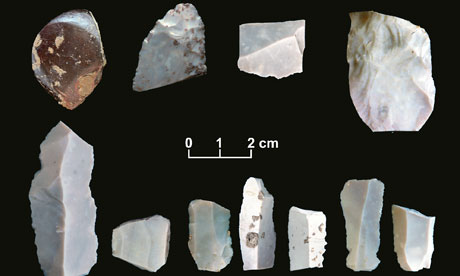Humans first arrived in North America more than 2,500 years earlier than previously thought, according to an analysis of ancient stone tools found in Texas. And the people who left them appear to have developed a portable toolkit used for killing and preparing meat.
Researchers found a haul of thousands of artefacts near the state capital, Austin, some of which were identified as blades and other tools. The material was buried in sediments that are between 13,200 and 15,500 years old.

Stone tools were found in 15,500-year-old sediment, pushing back the oldest evidence of human occupation in North America. Photograph: Michael R Waters/Science
There are problems with this story, however. Clovis-like tools, known for their distinctive fluted points, have never been found in northeastern Asia. And stone tools found in Alaska are too young (and too different) to be associated with Clovis.
"This discovery challenges us to rethink the early colonisation of the Americas," said Waters. "There's no doubt these tools and weapons are human-made and they date to about 15,500 years ago, making them the oldest artefacts found both in Texas and North America."
He added: "This makes the Friedkin site the oldest credible archaeological site in Texas and North America. The site is important to the debate about the timing of the colonisation of the Americas and the origins of Clovis."
The researchers think that the tools were made small so they could be used in a mobile toolkit, easily packed up and moved to a new location. Though the tools are noticeably different from the Clovis technology, Waters thinks that they could be related. "This discovery provides ample time for Clovis to develop. People [from the Buttermilk Creek Complex] could have experimented with stone and invented the weapons and tools that we now recognise as Clovis ... In short, it is now time to abandon once and for all the 'Clovis First' model and develop a new model for the peopling of the Americas."
Researchers found a haul of thousands of artefacts near the state capital, Austin, some of which were identified as blades and other tools. The material was buried in sediments that are between 13,200 and 15,500 years old.

Until now, the oldest evidence for human occupation in North America has come from the Clovis site in New Mexico. Scientists think that these people came to North America around 13,000 years ago by crossing the Bering Land Bridge from northeastern Asia. From there, they are thought to have spread across the northern and southern American continents.
Michael Waters from Texas A&M University led a team of researchers to study the Debra L. Friedkin site in Texas, about 40 miles northwest of Austin. Buried underneath the layer of rock that has been associated with the time period for the Clovis humans, his team found more than 15,000 objects that indicated the presence of an older civilisation.
He added: "This makes the Friedkin site the oldest credible archaeological site in Texas and North America. The site is important to the debate about the timing of the colonisation of the Americas and the origins of Clovis."
The analysis of the artefacts found at the site, which researchers have called the Buttermilk Creek Complex, is published in the latest issue of Science. "Most of these are chipping debris from the making and re-sharpening of tools, but over 50 are tools," said Waters. "There are bifacial artefacts that tell us they were making projectile points and knives at the site. There are expediently made tools and blades that were used for cutting and scraping."
The stone tools at Buttermilk Creek were dated using an optical technique called luminescence dating, which uses changes in luminescence levels in quartz or feldspar as a clock to pinpoint the time that objects were buried in sediment. "We found Buttermilk Creek to be about 15,500 years ago – a few thousand years before Clovis," said Steven Forman of the University of Illinois, who is a co-author on the paper. He added that it was the first identification of pre-Clovis stone tool technology in North America.





0 komentari:
Objavi komentar